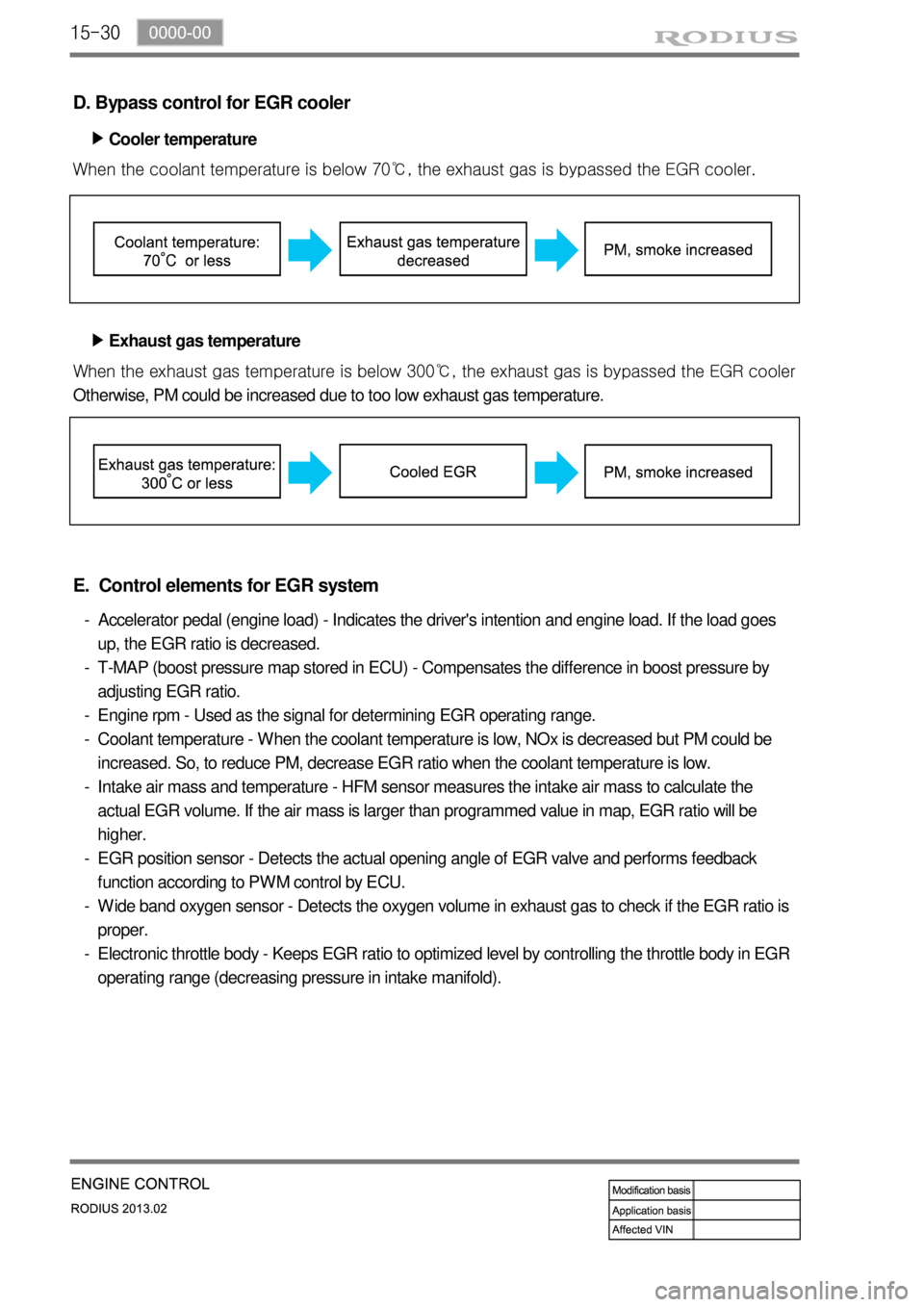Page 357 of 796
15-290000-00
C. Input/Output of E-EGR system
Page 358 of 796

15-30
D. Bypass control for EGR cooler
Cooler temperature ▶
When the coolant temperature is below 70℃, the exhaust gas is bypassed the EGR cooler.
Exhaust gas temperature ▶
When the exhaust gas tem
perature is below 300℃, the exhaust gas is bypassed the EGR cooler
Otherwise, PM could be increased due to too low exhaust gas temperature.
E. Control elements for EGR system
Accelerator pedal (engine load) - Indicates the driver's intention and engine load. If the load goes
up, the EGR ratio is decreased.
T-MAP (boost pressure map stored in ECU) - Compensates the difference in boost pressure by
adjusting EGR ratio.
Engine rpm - Used as the signal for determining EGR operating range.
Coolant temperature - When the coolant temperature is low, NOx is decreased but PM could be
increased. So, to reduce PM, decrease EGR ratio when the coolant temperature is low.
Intake air mass and temperature - HFM sensor measures the intake air mass to calculate the
actual EGR volume. If the air mass is larger than programmed value in map, EGR ratio will be
higher.
EGR position sensor - Detects the actual opening angle of EGR valve and performs feedback
function according to PWM control by ECU.
Wide band oxygen sensor - Detects the oxygen volume in exhaust gas to check if the EGR ratio is
proper.
Electronic throttle body - Keeps EGR ratio to optimized level by controlling the throttle body in EGR
operating range (decreasing pressure in intake manifold). -
-
-
-
-
-
-
-
Page 359 of 796
15-310000-00
F. Features
As EGR ratio goes up, smoke volume will be
higher. But, this lowers the combustion
chamber temperature and accordingly the
concentration of NOx is decreased. The point
with highest NOx is immediately after TDC.As EGR temperature goes up, the
concentration of NOx will be higher. Thus, it is
necessary to cool down the exhaust gas.
However, during engine cooled, it may cause
large amount of PM. To prevent this, the
exhaust gas is bypassed the EGR cooler.
Page 363 of 796
15-350000-00
HFM (intake air
temperature)CDPF
Electric throttle
bodyCoolant
temperature
sensorOxygen sensor
Injector (C3I)
E-EGR valve
(11) Wide band oxygen sensor control
A. Overview
For diesel engine, combustion is not performed at the optimum (theoretically correct) air-fuel ratio and
the oxygen concentration is thin in most cases. So the wide-band oxygen sensor is used for this kind o
f
engine, and this sensor is a little different from the one that used for gasoline engine. The combustion
in diesel engine is controlled by fuel injection volume. Therefore, the wide band oxygen sensor should
be used in diesel engine. This sensor measures the air-fuel ratio in very wide range, and is also called
full range oxygen sensor.
The wide band oxygen sensor measures the oxygen density in exhaust gas and sends it to ECU
to control the EGR more precisely. -
B. Components
D20DTR ECU
Page 372 of 796
15-44
(14) Immobilizer control
A. Overview
The Immobilizer System provides an additional theft deterrent to the vehicle in which it is installed and
prevents it from being started by unauthorized persons. The transponder integrated in the key and the
engine control unit have the same code. When the ignition key with the integrated transponder is
turned to the ON position, the ECU (Engine Control Unit) checks the crypto code of the key and, if
correct, allows the vehicle to start the engine.
B. Components
Basic components (ignition key system) ▶
D20DTR ECUImmobilizer antennaIndicator/Warning Lamp
Start motorImmobilizer key
Page 374 of 796
15-46
(15) CDPF control
A. Overview
As the solution for environmental regulations and PM Particle Material) of diesel engine, the low
emission vehicle is getting popular. This vehicle is equipped with an extra filter to collect the soot and
burn it again so that the amount of PM in the exhaust gas passed through the DOC (Diesel Oxidation
Catalyst) is reduced. The CDPF (Catalyst & Diesel Particulate Filter) is an integrated filter including
DOC (Diesel Oxidation Catalyst) and DPF (Diesel Particulate Filter).
For details, refer to Chapter "CDPF".
B. Components
Oxygen sensorFront
EGT sensorCDPF
(DOC + DPF)Rear
EGT sensor
Differential pressure
sensorD20DTR ECUElectric throttle body
Page 388 of 796

03-32211-22
1. FUEL SYSTEM SPECIFICATION
Use Only Unleaded Fuel Rated at 89 Octane or Higher ▶
Fuel quality and additives contained in fuel have a significant effect on power output, drivability, and life
of the engine. Fuel with too low an octane number can cause engine knock.
Do Not Use Methanol ▶
Fuels containing methanol (wood alcohol) should not be used in vehicle.
This type of fuel can reduce vehicle performance and damage components of the fuel system.
Vehicle Fueling from Drums or Storage Containers ▶
For safety reasons (particularly when using noncommercial fueling systems) fuel containers, pumps
and hoses must be properly earthed. Static electricity build up can occur under certain atmospheric
and fuel flow conditions if unearthed hoses, particularly plastic, are fitted to the fuel-dispensing pump.
It is therefore recommended that earthed pumps with integrally earthed hoses be used, and that
storage containers be properly earthed during all noncommercial fueling operations.
Page 480 of 796
03-6
2. OVERVIEW
The Immobilizer System provides an additional theft deterrent to the vehicle in which it is installed and
prevents it from being started by unauthorized persons. The transponder integrated in the key and the
engine control unit have the same code. When the ignition key with the integrated transponder is
turned to the ON position, the ECU (Engine Control Unit) checks the crypto code of the key and, if
correct, allows the vehicle to start the engine. If the verification has been failed, the engine cannot be
started and the immobilizer warning lamp blinks.
Immobilizer unit